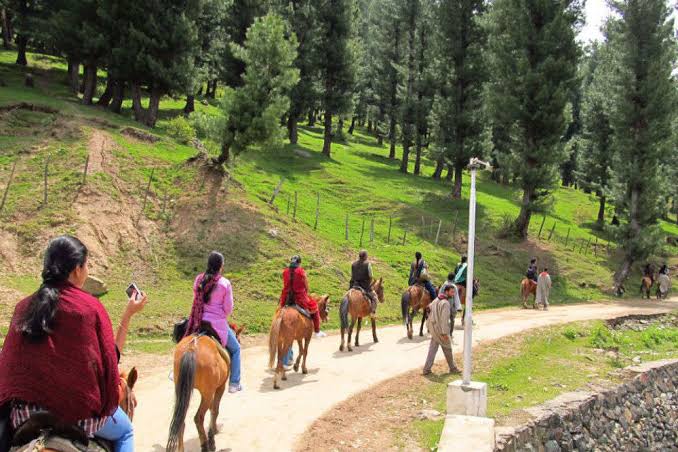Tourism bridges the emotional and psychological gap between the people of Jammu & Kashmir and the rest of India. It tells Kashmiris that they are loved, respected, and embraced. And it tells the rest of India that Kashmir is not just a piece of land—it is a living, breathing part of our shared national identity. Tourism promotes cultural exchange organically and respectfully.
In the wake of the abrogation of Article 370, the Modi-led government has made unprecedented efforts to transform Jammu & Kashmir from a conflict-hit region into a peaceful and progressive tourist destination. A new chapter of integration, infrastructure, and investment began unfolding—especially in the tourism sector. Under the “Naya Kashmir” vision, tourist footfall broke all previous records, crossing 2 crore in 2023 alone. Forgotten and untouched areas like Keran, Gurez, Tangdhar, Machil, Teetwal, and Bangus Valley were put on the tourism map through the bold and visionary concept of Border Tourism. This was not just about opening beautiful places to visitors, but about opening hearts, building bridges, and sending a powerful message to the world: Jammu & Kashmir is peaceful, secure, and united with the rest of India. This momentum must not be lost. The recent Pahalgam attack, while tragic, must not derail the remarkable journey of revival that Kashmir has embarked upon. On the contrary, it demands a stronger collective resolve to protect, promote, and preserve the peace and prosperity that tourism brings.
Tourism is not just an industry in Jammu & Kashmir—it is a barometer of normalcy. When tourists walk freely on the streets of Srinagar, enjoy homestays in Gurez, or sip kahwa in the apple orchards of the valley, they are unknowingly participating in the restoration of peace. Their presence reflects confidence in governance, security, and coexistence. That confidence must not be allowed to fade in the face of terror. The revival of tourism post-attack is a message to the enemies of peace that violence will not dictate Kashmir’s destiny. Every tourist that chooses to return is a footstep against fear and a loud vote for harmony. Tourism is the economic backbone of lakhs of families in the J&K. It supports hoteliers, shikarawalas, taxi drivers, artisans, dry fruit vendors, and pony operators. For the youth of J&K, tourism is not just employment—it is empowerment. New ventures, startups, and homestay schemes supported by the government have given young Kashmiris a dignified livelihood and a stake in peace.
In the post-370 era, the government’s policies have made tourism a central component of economic development. From upgraded infrastructure to promotional campaigns, the efforts are visible and impactful. And when incidents like the Pahalgam attack occur, we must work twice as hard to prevent economic disruption and protect the aspirations of our youth.
Strengthening National Unity: Tourism as a Bridge
One of the most beautiful outcomes of tourism in Kashmir is its power to create human bonds. When families, students, professionals visit the Valley, it helps break decades-old barriers of misinformation, fear, and alienation. These are not political exchanges—they are people-to-people connections that reinforce the spirit of Ek Bharat, Shreshtha Bharat. Tourism bridges the emotional and psychological gap between the people of Jammu & Kashmir and the rest of India. It tells Kashmiris that they are loved, respected, and embraced. And it tells the rest of India that Kashmir is not just a piece of land—it is a living, breathing part of our shared national identity. Tourism promotes cultural exchange organically and respectfully. It introduces the rest of India to Kashmir’s pluralistic ethos and brings India’s diversity into the Valley in a spirit of mutual admiration. This cultural exchange dismantles the walls of isolation and builds a common language of understanding. It strengthens the Indian identity of Kashmir while also preserving and celebrating its unique local traditions.
Strategic Diplomacy Through Tourism
Revival of tourism is not just about domestic policy—it has international ramifications. A vibrant and safe tourism scene in Kashmir exposes and defeats propaganda pushed by anti-India elements on global platforms. When international tourists post pictures from Gurez or write blogs on the hospitality of Kashmiris, they counter misinformation with lived experiences. Tourism becomes a subtle yet powerful tool of diplomacy—proving that peace is not just promised, it is practiced.
Let us be honest: those who attacked tourists in Pahalgam weren’t just targeting innocent lives. They were targeting the very idea of unity between Kashmiris and fellow Indians. They fear what tourism represents—connection, development, and acceptance. They want to isolate Kashmir and keep it trapped in a narrative of conflict and grievance. But this new Kashmir, confident in its culture and committed to progress, refuses to be held hostage. The more people-to-people contact grows, the weaker divisive ideologies become. Every tourist that returns safely is a blow to separatist agendas. Every Kashmiri smile captured in a tourist’s photo is a victory for peace. The revival of tourism is not just about business—it is about belief. Belief in peace. Belief in unity. Belief in a better future. The Modi government’s bold decisions have laid the foundation for this transformation. It is now our responsibility—as citizens, as civil society, as Kashmiris and as Indians—to protect this progress.
Tourism as a Tool for Peacebuilding and Global Narrative Shift in Kashmir
The revival of tourism in Jammu and Kashmir is no longer just a matter of economic policy or local administration—it is a pillar of India’s strategic diplomacy. In a region long projected internationally through the lens of conflict, a vibrant and secure tourism environment challenges hostile narratives with evidence of ground realities. It provides the most humane and persuasive counter to propaganda: real people, real smiles, and real stories. When a foreign tourist shares a photograph from Gulmarg, a travel vlogger publishes a video from Keran Valley, or a backpacker pens a blog describing the warmth and hospitality of Kashmiri families, it becomes an act of silent diplomacy. These lived experiences undermine decades of misinformation and anti-India elements on international platforms. Every shared moment becomes a testament to normalcy and peace—a counter-narrative more powerful than any press release or televised debate.
Let’s be honest and courageous in our assessment: those who orchestrated the recent attack on tourists in Pahalgam were not merely committing a heinous crime against innocent lives. They were making a strategic attempt to sabotage peace. Their target was much larger—it was the very idea of unity between Kashmiris and the rest of India. They understand what tourism symbolizes: integration, interdependence, development, and acceptance. They fear that a flourishing tourism sector will expose their irrelevance, reveal the lies they propagate, and forge a new people-to-people relationship that permanently closes the doors to division. What they fear most is not a bullet—it is a smile. A Kashmiri hosting a family from Delhi , a shepherd in Tulail guiding trekkers, a group of students from Tamil Nadu exploring Mughal Road—these are scenes that stitch the social fabric tighter. And every time a tourist returns safely with a changed perspective, a new window opens into the real Kashmir—one of harmony, aspiration, and coexistence.
Tourism is therefore not just an industry—it is a movement. It is a movement that reclaims Kashmir from the shadows of imposed narratives and presents it as a living example of peace through participation. It is also a grassroots form of diplomacy, where every hotel owner, shikara rider, and artisan becomes an ambassador of India’s unity and Kashmir’s resilience. The Modi government’s decisive interventions—whether infrastructural, constitutional, or administrative—have laid the groundwork for this transformation. The abrogation of Article 370, increased investment in border tourism, restoration of village homestays, and enhanced security measures have all contributed to creating an atmosphere where both domestic and international tourists can visit without fear. Let us understand this clearly: every safe tourist journey is a blow to terrorism. Every sunset captured over Wular Lake is a strike against separatism. And every shared laughter in a Kashmiri bazaar is a beacon of hope—showing that peace is not just promised; it is practiced. The future of Kashmir lies in such interactions—in the lived unity between its people and visitors, not in slogans of division.
It is now our collective duty—Kashmiris and fellow Indians alike—to protect and nurture this transformation. Let us not allow fear to undo what faith has begun. Let us make tourism not only a driver of the economy but the soul of our strategic diplomacy.
(The views expressed are the author's own and do not necessarily reflect the position of the organisation)


